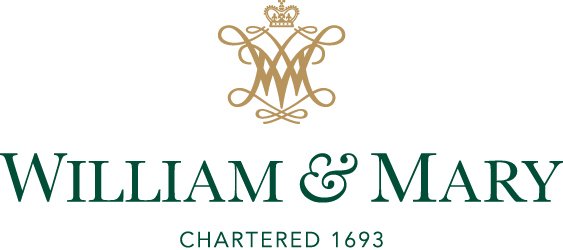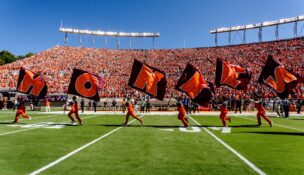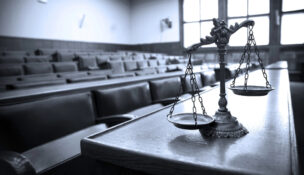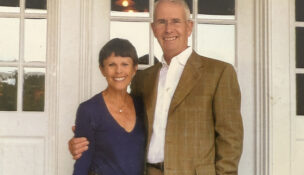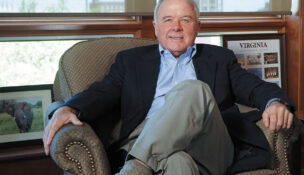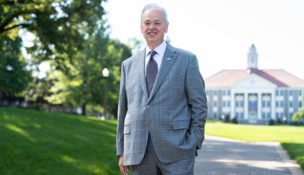The road to reconciliation
William & Mary increases efforts to promote racial equity, healing
The road to reconciliation
William & Mary increases efforts to promote racial equity, healing
William & Mary’s first African American dean is seeking to transform the university’s law school in ways both fundamental and symbolic.
Introducing a 12-part action plan titled “Why We Can’t Wait — An Agenda for Equity and Justice,” A. Benjamin Spencer says he intends to train a generation of lawyers who will focus on “this enduring inequity and injustice that the country just can’t seem to shake.”
Invoking the Rev. Martin Luther King Jr.’s call to action, Spencer has outlined 12 initiatives that include a new Center for Racial & Social Justice, a community law clinic and scholarships for students dedicated to becoming advocates for equal justice.
But with only seven African Americans in his first-year class of 230 law students, Spencer also has set about changing imagery and first impressions to make the nation’s oldest law school more welcoming.
“A lot of the preexisting messaging is oriented in the 18th century,” Spencer says. “Even the diversity page that we used to have, the first few sentences were about the 1700s and Thomas Jefferson.”
Spencer’s quest to make W&M more inclusive is a goal reflected in social justice initiatives across the university, says Chon Glover, W&M’s chief diversity officer. Some efforts have been years in the making, such as The Lemon Project, a university initiative described as an “attempt to rectify wrongs perpetrated against African Americans by William & Mary through action or inaction.” It plans to erect a memorial to African Americans enslaved by the university.
But other efforts, including new principles for naming and renaming structures and spaces on campus, are the result, she says, of “the national awakening and reckoning” after the May 25 police killing of George Floyd in Minneapolis.
Anthony M. Joseph, president of the W&M Student Assembly, sees a new urgency “to prioritize and put in the forefront of the conversation” some ongoing issues, especially the treatment of Black and brown students.
During the fall 2020 semester, the Student Assembly launched the Police Policy Project to collect and analyze data on student-police interactions on and off campus, he says.
It is focused “minutely and acutely” on Obama administration policy recommendations for 21st century policing that emphasize “leading with respect and integrity,” Joseph says.
People might think “Williamsburg is not Minneapolis,” he says. “But we are always one step away from that happening, and it starts with perceived or apparent lack of respect.”
A heavy ‘Hearth’
Making W&M a more welcoming place to Williamsburg’s African American community is another priority, he says. Joseph served on the committee that worked on the naming guidelines, which acknowledged that the university “has not been welcoming and inclusive for all.”
Joseph says an important step toward that goal will be the creation of a memorial to the African Americans enslaved by William & Mary, a public reminder similar to the memorial to enslaved people installed at the University of Virginia earlier this year.
William & Mary’s $2 million memorial is scheduled for groundbreaking in early 2021 and completion in fall 2021. It will break through the wall that surrounds the university’s Historic Campus, the two-acre, diamond-shaped area containing university buildings dating from the 1600s and 1700s. It will also create a new entranceway for the campus.
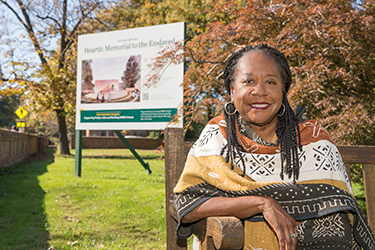
The Lemon Project, a university initiative to “rectify wrongs
perpetrated against African Americans by William & Mary.”
Black residents have “a historical memory of when the college walls went up,” Joseph says, and felt “they were being pushed out” at the time Colonial Williamsburg was established.
Jody Lynn Allen, director of The Lemon Project, says African American residents saw the wall “as a real barrier, a way of keeping them out. So, the memorial is breaking that wall, literally and figuratively.”
Titled “Hearth,” the memorial will measure 16 feet wide, 45 feet long and 20 feet high, and resemble a brick fireplace. It will be built by Richmond-based construction firm Kjellstrom & Lee Inc. across from the admissions office on the south side of the 1690s Wren Building, the oldest building on campus.
“The hearth has two meanings in the life of the enslaved,” explains Allen, an assistant professor of history. There was the harsh hearth they labored around, firing bricks and boiling water for laundry. But there was also the hearth they could gather around when they had moments to themselves.
“The hearth illuminates, so it illuminates the fact that they were there and that they were human beings,” she says.
The Lemon Project is named for Lemon, a man who was enslaved by W&M, and his name will be one of about 190 to be included on the memorial. In instances when the names of enslaved people were not recorded, those people will be listed by the work they did, Allen says. More names will be added as The Lemon Project’s research continues.
“It’s a reparative endeavor,” Allen says of the project, which was established by the board of visitors in 2009 as the result of a Student Assembly resolution. The project’s next phase will be to conduct genealogy research to trace descendants of those who were enslaved by the university.
More than $1 million in private donations was raised for the memorial; the board of visitors, which in 2018 apologized for W&M’s role in slavery, provided matching funds.
Richmond-based architectural firm Baskerville designed the memorial based on a concept chosen after an international competition. The winning proposal was submitted by William Sendor, a 2011 alumnus.
“What he did was to use this symbol to remember the past but also, as we move forward, to rekindle their memory,” Allen says.
“The final concept design has the gravitas we sought. It gives dignity and presence to those who were enslaved by William & Mary and whose labor built the university – without romanticizing that painful history,” W&M President Katherine A. Rowe said in a statement issued in August. “In the process of refining the design, we recognized that the memorial site will reimagine the Jamestown Road entrance to campus. Both symbolically and actually, the first step for many on campus will be through this more forthright telling of our history.”
Pursuing equity
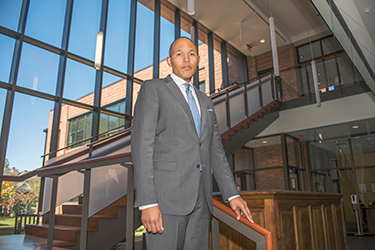
In September, the W&M board also approved new principles for naming and renaming university buildings and other assets. One change quickly approved was the renaming of Trinkle Hall — named for E. Lee Trinkle, a Jim Crow-era Virginia governor — to Unity Hall.
Glover says the working group that recommended the naming principles heard from people on both sides of the issue: alumni “who were very protective of the William & Mary they knew,” but also students “who expressed how uncomfortable and alienating it felt to walk around campus and to not see any kind of balance.”
Changes might seem to be happening too quickly for some and too slowly for others, but she sees it as more of an evolution. Glover says W&M isn’t the same university it was when she arrived in 1996 for her first job with student affairs.
“The civic discourse has changed,” she says. Students expect a different learning environment that reflects a broad definition of diversity that includes race, religion, gender and gender identity, “but also political thought. … They know that in order to be true, critically thinking leaders they need to have all those perspectives.”
At the law school, Spencer plans to increase diversity, not just in the student body but also in the imagery on the school’s walls and website.
The law school has been a lonely place during his first semester on the job. With nine children at home, Spencer is one of the few people who have opted to work from the office each day rather than remotely during the pandemic.
When he finally can welcome visitors to his office, he hopes to show them a portrait of one of his role models, Charles Hamilton Houston. Houston was the Howard University Law School dean and NAACP special counsel who helped dismantle U.S. segregation laws. Like Spencer, he was a Harvard Law graduate. “He trained lawyers who went on to change the country,” Spencer says.
Among Spencer’s goals is to establish need-based scholarships to attract more students of color. “I don’t know what the right number is,” he says, “but it’s not seven Black students.”
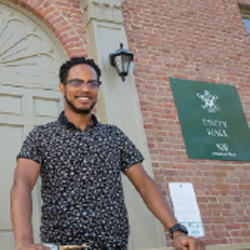
Merit scholarships, which are based on academic scores, he says, contribute to an inequitable system in which lower income students who are paying full price “end up subsidizing students who are getting scholarships.”
Spencer is the son of retired U.S. District Judge James R. Spencer, who was the first African American chief judge for the Eastern District of Virginia and the first Black federal judge in Virginia. The younger Spencer was on the law faculty of the University of Virginia when he was selected as the first African American dean of any school at W&M.
Founded in 1693, W&M is the nation’s second-oldest college, behind Harvard, but its law school is ranked as the oldest in the country. Spencer, who became dean in July, began formulating his agenda soon after the killing of George Floyd. But he says the course he has set is not new.
The law school was founded “to train citizens who are going to be engaged in civic life,” Spencer says. “That’s part of the legacy of the school already.”
At a glance
Founded The second-oldest university in the United States, William & Mary was established in 1693 under a royal charter signed by King William III and Queen Mary II of of England, Ireland and Scotland.
Campus Stretching across 1,200 acres in downtown Williamsburg, William & Mary includes the Martha Wren Briggs Amphitheatre, Lake Matoaka and College Woods. Its circa-1695 Wren Building is the oldest U.S. university building still in use.
Enrollment (fall 2020)
Undergraduate: 6,236
Graduate: 2,703
Class of 2024: 1,525
Student Profile
African American/Black: 7%
Asian/Pacific Islander: 11%
Hispanic/Latino: 8%
White: 60%
Virginia residents: 67%
Female: 61%
Male: 39%
Employees
The largest employer in Williamsburg, William & Mary employs more than
2,400 people.
Faculty*
754 full-time and 181 part-time faculty
Tuition and fees, housing and financial aid*
In-state tuition and fees: $23,628
Out-of-state tuition and fees: $46,854
Room and board: $12,926
Average financial aid awarded to full-time, in-state freshmen seeking
assistance in 2018-19: $19,449
*2019-20 data
l


